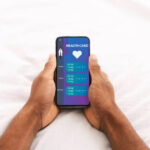This week’s Remote Patient Monitoring Research Roundup explores three newly published studies highlighting the use of digital tools, wearables, and chronic care remote patient monitoring (RPM). These studies provide factual insights into the perspectives, outcomes, and potential challenges associated with digital tools for chronic care management.
Perspective on Digital Tools for Chronic Disease Management
A study conducted by the University of Tennessee Health Science Center focused on understanding the perspectives of individuals using digital tools for managing chronic diseases. The survey involved 26 participants, primarily middle-aged females with conditions such as diabetes or hypertension.
Key Findings:
- Digital Health Technology Usage: The study found that a significant 71% of participants had previously used some form of digital health technology for managing their illnesses, including mobile apps, telehealth, patient portals, or remote monitoring.
- Preferred Features: Participants preferred digital tools with features such as medication reminders, diet/nutrition guidance, and access to educational resources.
- Acceptance of Telemedicine: Over three-quarters of respondents felt that telemedicine and mobile health (mHealth) apps could improve chronic disease management.
- Comfort with Electronic Monitoring: An equal proportion of participants reported feeling comfortable electronically monitoring their health data and sharing it with their healthcare provider.
- Outcomes: Nearly 73% of participants agreed that using mobile apps helped better control their chronic condition, emphasizing the convenience of self-management and reduced clinic waiting times.
This study adds to the growing evidence supporting the promise of digital health tools in augmenting chronic disease care. Participants recognized the advantages of mHealth apps and expressed openness to more integrated use. As remote care options expand, insights from users become crucial for the evolution of patient-centered, effective platforms. Engaging patients actively in the development and adoption process is essential for healthcare organizations.
COPD Chronic Care Remote Patient Monitoring
A recent review published in Nature explored the impact of wearable devices on patients with chronic obstructive pulmonary disease (COPD). The analysis encompassed 37 studies with nearly 3,000 participants.
Key Findings:
- Increased Physical Activity: Wearables led to a significant increase in daily step counts, averaging around 850 more steps, meeting the threshold for a clinically meaningful change.
- Enhanced Walking Capacity: Participants using wearables showed improved walking capacity measured by the 6-minute walk test, though the improvement fell slightly short of the minimal clinically important difference.
- Quality of Life Impact: Wearables led to a small, likely negligible drop in COPD assessment test scores, indicating minimal impact on quality of life. They did not significantly affect time in moderate-vigorous activity or leg strength.
- Effectiveness of Combinations: Combining wearables with coaching or pulmonary rehab yielded positive outcomes, with almost 1,000 more daily steps than usual care.
- Limitations and Future Considerations: While wearables show promise in increasing activity levels in COPD patients, benefits diminished beyond 3 months, and overall quality of life remained largely unchanged. Further research is essential for long-term impacts and cost-effectiveness before integration into routine care.
This review highlights the potential of digital health technology in COPD self-management but emphasizes the need for personalized guidance and shared decision-making with healthcare teams. When combined with additional support, wearables show promise in enhancing activity levels. However, sustained benefits and long-term impacts necessitate further investigation before integration into routine care.
Evaluating a Chronic Care Remote Patient Monitoring System for Respiratory Diseases
A recent study published in JMIR Publications tested a multi-component remote monitoring system for patients with respiratory illnesses, including COPD or COVID-19 aftereffects. The observational trial enrolled 60 patients over 180 days to assess the feasibility of chronic care remote patient monitoring commercial wearables, home spirometry, and apps in collecting data for guiding care.
Key Findings:
The observational trial enrolled 60 patients to use the toolkit for 180 days. Adherence was highest for passive data from wearables worn 18 hours daily. Meanwhile, home spirometry completion lagged at just 59%, confirming it placed a high burden on users.
- Adherence Patterns: Passive data from wearables, worn 18 hours daily, exhibited the highest adherence, while home spirometry completion lagged at just 59%, indicating a higher burden on users.
- Engagement Sustainment: Wearable sensors and periodic surveys sustained engagement over the six months, whereas adherence to active app entries and spirometry declined more rapidly.
- Protocol Breaks and Flexible Support: Allowing protocol breaks and providing flexible support improved retention and overall participant experience.
- Quality of Home Spirometry: 90% of home spirometry attempts met quality standards for clinical utility.
The study provides valuable insights into the feasibility and acceptance of different components of a remote monitoring system for respiratory diseases. Passive, continuous monitoring via wearables demonstrated particular promise for managing respiratory conditions. The findings suggest that wearable biosensors enabling round-the-clock vital sign tracking at low user burden could become vital for early disease intervention. Additional research into accuracy is needed, but chronic care remote patient monitoring technologies stand to relieve pressures on both patients and health systems greatly.
Understanding 3 New Chronic Care Remote Patient Monitoring Studies
These three studies contribute factual insights into chronic care and remote patient monitoring. From the perspectives on digital tools for chronic disease management to the role of wearables in COPD management and the evaluation of a remote monitoring system for respiratory diseases, each study offers valuable data. This week’s studies underscore the potential benefits, challenges, and areas for improvement in chronic care remote patient monitoring.
To subscribe to Tenovi’s Weekly Research Newsletter, scroll down and find the subscription link below. If you are part of a chronic care management, telehealth, or remote patient monitoring company, explore Tenovi RPM solutions. Book your free demo and consultation with us today.






